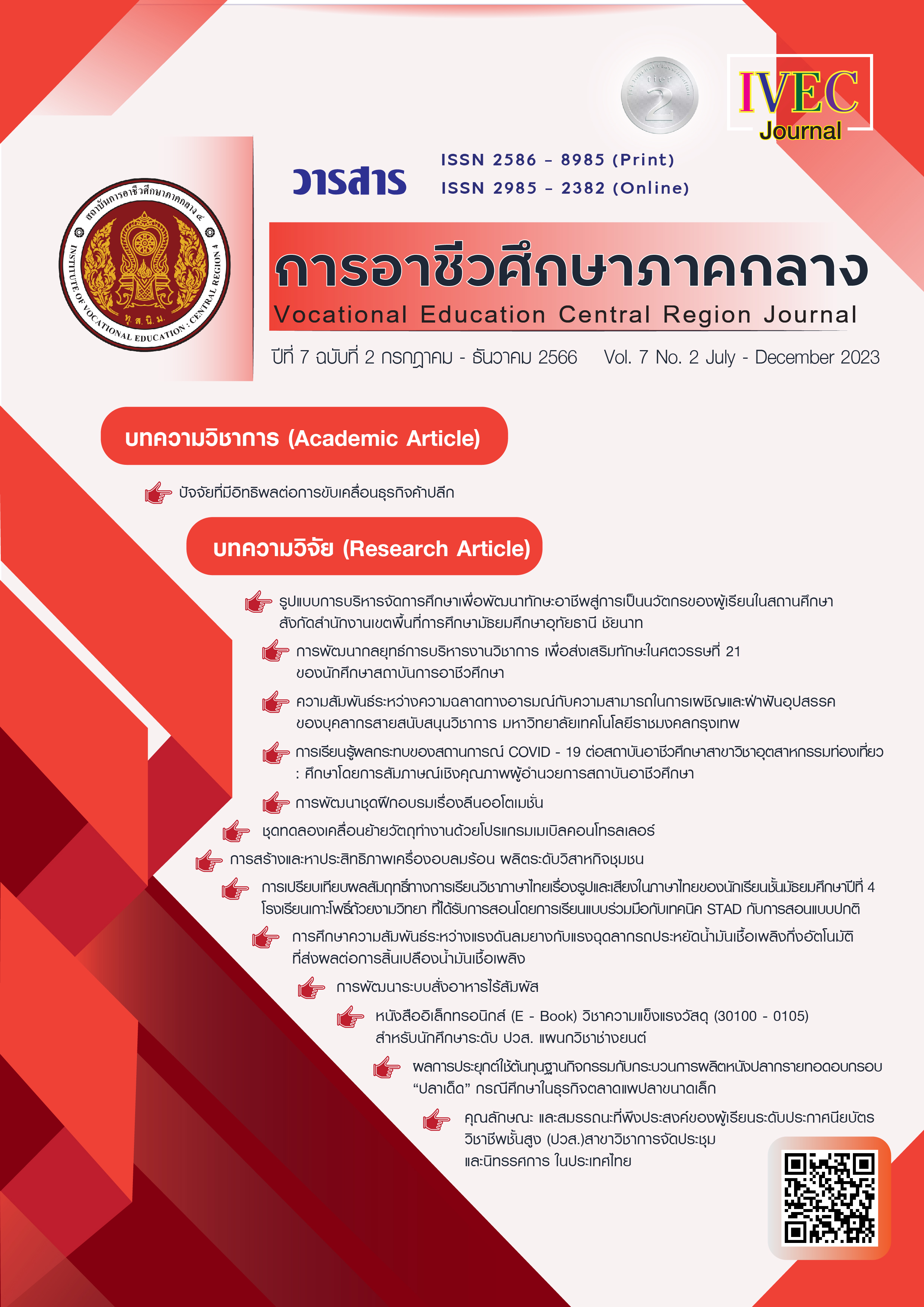The Administration Model for Occupational Skill Development to Innovators of Learners in Schools under Uthai Thani Chainat Educational Service Area Office
Main Article Content
Abstract
The objectives of this research were to : 1) study guidelines the administration model for occupational skill development to innovators of learners in schools under Uthai Thani Chainat Educational Service Area Office , 2) develop the administration model for occupational skill development to innovators of learners in schools under Uthai Thani Chainat Educational Service Area Office , and 3) study the results of using and evaluating the effectiveness of the administration model for occupational skill development to innovators of learners in schools under Uthai Thani Chainat Educational Service Area Office. The research instruments employed were the evaluation form and the focus group discussion form. The data analysis used were mean, standard deviation (S.D.), and content analysis. The population comprised 34 secondary schools under Uthai Thani Chainat Educational Service Area Office, which classified into 21 secondary schools in Uthai Thani province, and 13 secondary schools in Chainat province. The research findings were as follows: (1) The administration, the learning management, and the learner's learning overall was at a high level. The guidelines provided for the administration model for occupational skill development to innovators of learners in schools under Uthai Thani Chainat Educational Service Area Office were the instructional adaptation, which changed learners to have the innovator characteristics. Moreover, the learners were able to find their own capacities , talents , and needs , the variety of instructions , the participation of school administrators , teachers , parents , and communities in order to build change , and promote learners design and evaluate for development continuously by using 3 components were principles and concepts , objectives , and development process , which divided into 2 levels : the secondary educational service area office level by using 7S process consisted of (1) S : Synthesis , (2) S : Strategy Planning , (3) S : Support (4) S : Supervision , (5) S : Success , (6) S : Showcase , and (7) S : Sustainability , and in the level of schools using New LOOK process comprised (1) L : Learning , (2) O : Occupation , (3) O : Outcome , and (4) K : Knowledge , which divided into 3 aspects were school administrator administrations , teacher instructions , and learner learning by using the administration model for occupational skill development creatively in order to be the New LOOK. (2) the results of the model development, and the implement with the target group found that the overall results had the same levels were school administrator administrations, teacher instructions, and learner learning at a high level. The learners’ parents, the basic education board, and the heads of communities had the satisfaction with the model at the highest level, and the components for the successful factors should be added were Professional Learning Community: PLC), and digital technology.
Article Details

This work is licensed under a Creative Commons Attribution-NonCommercial-NoDerivatives 4.0 International License.
|
บทความ ข้อมูล เนื้อหา รูปภาพ ฯลฯ ที่ได้รับการตีพิมพ์ในวารสาร การอาชีวศึกษาภาคกลาง ถือเป็นลิขสิทธิ์ของวารสารการอาชีวศึกษาภาคกลางหากบุคคลหรือหน่วยงานใดต้องการนำทั้งหมดหรือส่วนใดส่วนหนึ่ง ไปเผยแพร่ต่อหรือเพื่อกระทำการใด ๆ กองบรรณาธิการไม่สงวนสิทธิ์ ในการคัดลอกบทความเพื่อการศึกษาแต่ให้อ้างอิงแหล่งที่มาให้ครบถ้วน สมบูรณ์ สงวนสิทธิ์ โดย สถาบันการอาชีวศึกษาภาคกลาง 4 ที่ตั้ง 90 ถนนเทศา ตำบลพระปฐมเจดีย์ อำเภอเมือง จังหวัดนครปฐม โทรศัพท์ 034 242 856 , โทรสาร 034 242 858 ISSN : 3056-9176 (print) ISSN : 2985-2382 (online) |
References
ณัฐรดา วงษ์นายะ. (2555). การพัฒนารูปแบบการจัดการความรู้เครือข่ายสื่อเพื่อเด็กและเยาวชนภาคเหนือ. วิทยานิพนธ์ ปริญญาปรัชญาดุษฎีบัณฑิต สาขาวิชาพัฒนศึกษา บัณฑิตวิทยาลัย มหาวิทยาลัยศิลปากร.
ดุษฎี โยเหลา และคณะ. (2557). การศึกษาการจัดการเรียนรู้แบบ PBL ที่ได้จากโครงการสร้างชุดความรู้เพื่อสร้างเสริมทักษะแห่งศตวรรษที่ 21 ของเด็กและเยาวชน : จากประสบการณ์ความสำเร็จของโรงเรียนไทย. กรุงเทพฯ : ทิพยวิสุทธิ์.
ทวีวรรณ อินดา. (2552). การพัฒนารูปแบบที่มีประสิทธิภาพของการนำกลยุทธ์ไปปฏิบัติในสถาบันอุดมศึกษาของรัฐ. ดุษฎีนิพนธ์ ปริญญาปรัชญาดุษฎีบัณฑิต บัณฑิตวิทยาลัย มหาวิทยาลัยศิลปากร.
ธีรวุฒิ ชมใจ. (2554). การพัฒนารูปแบบความร่วมมือการจัดการอาชีวศึกษาระบบไตรภาคี. วิทยานิพนธ์ปริญญาการศึกษาดุษฎีบัณฑิต สาขาวิชาการบริหารการศึกษา บัณฑิตวิทยาลัย มหาวิทยาลัยศรีนครินทรวิโรฒ.
ประพันธ์ศิริ สุเสารัจ. (2553). การพัฒนาการคิด (พิมพ์ครั้งที่ 4). กรุงเทพฯ : 9119 เทคนิค พริ้นติ้ง.
วาโร เพ็งสวัสดิ์. (2553). การวิจัยพัฒนารูปแบบ. วารสารมหาวิทยาลัยราชภัฏสกลนคร, 2, (4), หน้า 1 - 15.
วิริยะ ฤาชัยพาณิชย์. (2558). การสอนแบบสร้างสรรค์เป็นฐาน Creativity - based Learning (CBL). วารสารนวัตกรรมการเรียนรู้, 1, (2), หน้า 23 - 37.
สำนักงานคณะกรรมการการศึกษาขั้นพื้นฐาน. (2561). นโยบายสำนักงานคณะกรรมการการศึกษาขั้นพื้นฐานปีงบประมาณ พ.ศ. 2561. โรงพิมพ์ชุมนุมสหกรณ์การเกษตรแห่งประเทศไทย.
สำนักงานคณะกรรมการพัฒนาการเศรษฐกิจและสังคมแห่งชาติ. (2562). ยุทธศาสตร์ชาติ พ.ศ. 2561 - 2580. กรุงเทพฯ : สำนักงานคณะกรรมการพัฒนาการเศรษฐกิจและสังคมแห่งชาติ.
สำนักงานปลัดกระทรวงศึกษาธิการ. (2559). แผนพัฒนาการศึกษาของกระทรวงศึกษาธิการ ฉบับที่ 12 (พ.ศ. 2560 - 2564). กรุงเทพฯ : สำนักงานปลัดกระทรวงศึกษาธิการ.
สำนักงานเลขาธิการสภาการศึกษา. (2550). แผนการจัดการเรียนรู้ที่เน้นผู้เรียนเป็นสำคัญ การจัดการเรียนรู้แบบส่งเสริมความคิดสร้างสรรค์. กรุงเทพฯ : ชุมนุมสหกรณ์การเกษตรแห่งประเทศไทย.
Joyce, B., & Weil, M. (1990). Model of teaching (3rd ed.). New Delhi: Prentice Hall.


